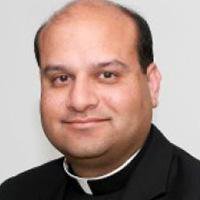
COMMENTARY: Although he has not celebrated Mass publicly since 2022, the Holy Father has made Eucharistic adoration a main focus.
Pope Francis marked the 12th anniversary of his election in a hospital, and that hospitalization casts light on the distinctive Eucharistic piety of the pontificate — one that emphasizes Eucharistic adoration rather than the Holy Mass itself.
During his hospitalization, the detailed daily medical bulletins noted that Pope Francis received Holy Communion each day and usually spent time praying in the hospital chapel, likely before the Blessed Sacrament.
Only on Sunday did he attend Mass celebrated by another priest. There was no indication that on weekdays the Mass was celebrated in his room, or that he attended Mass in the chapel.
This is consistent with his usual practice since 2021, where he has not been the principal celebrant of his public Masses, presumably due to diminished mobility. The last public Mass that Pope Francis celebrated was in May 2022 for the canonization of 10 saints.
The rubrics of the Roman Missal indicate that “whenever the Bishop is present at a Mass where the people are gathered, it is most fitting that he himself celebrate the Eucharist.” The General Instruction of the Roman Missal immediately adds that the bishop can be present without celebrating the Mass himself: “Having assigned someone else to do this, it is appropriate that [the Bishop] should preside over the Liturgy of the Word, wearing the pectoral cross, stole, and cope over an alb, and that he give the blessing at the end of Mass” (92).
During the final years of St. John Paul II, the Vatican prepared a special elevated wheelchair that enabled John Paul to remain seated while celebrating Mass, both at St. Peter’s and even on foreign trips. Pope Francis has chosen not to use that option.
It is not publicly known what the Holy Father does on weekdays. He used to celebrate his daily Mass with a congregation in the chapel of the Domus Sanctae Marthae, where he lives, but that has not been the case since the end of the pandemic.
The Eucharistic piety of Pope Francis is focused on Eucharistic adoration. Early in his pontificate, he would spend an hour in the morning before Mass and another hour in the evening in the chapel, praying before the Blessed Sacrament.
Among the signature moments of his pontificate was the Eucharistic adoration and Benediction he led in an empty St. Peter’s Square during the pandemic. In those dramatic early days, he chose to lead the entire Church in adoration of the Blessed Sacrament and bless the city and world — urbi et orbi — with the monstrance.
“From this colonnade that embraces Rome and the whole world, may God’s blessing come down upon you as a consoling embrace,” Pope Francis said. “Lord, may you bless the world, give health to our bodies and comfort our hearts.”
Another signature initiative of Pope Francis has been the Lenten “24 Hours for the Lord,” which consists of 24 consecutive hours (if possible) of adoration and confessions. The Holy Father participates in Rome, and every diocese is encouraged to select several parishes as designated sites.
Papal exhortations to return to Eucharistic adoration have been constant from the beginning of his pontificate.
“One cannot know the Lord without being in the habit of adoring, of adoring in silence,” Pope Francis said in 2016, lamenting that adoration had withered in the Church. “I believe, if I am not mistaken, that this prayer of adoration is the least known among us; it is the one we engage in the least. To waste time — if I may say it — before the Lord, before the mystery of Jesus Christ. To adore, there in the silence, in the silence of adoration. He is the Lord, and I adore him.”
In recent years, those appeals for adoration have become more frequent. In 2023, it became a matter of some urgency for him.
In June 2023, he blessed the monstrance that would be used at the 2024 National Eucharistic Congress in Indianapolis, granting an audience to a delegation visiting from the United States.
“I believe that we have lost the sense of adoration in our day. We must rediscover the sense of adoration in silence. It is a form of prayer that we have lost. Too few people know what it is. It is up to the bishops to catechize the faithful about praying through adoration. The Eucharist requires it of us.”
Later that summer, he made the same plea at World Youth Day in Lisbon.
“Only in adoration, only in the Presence of the Lord, do we truly rediscover our taste and passion for evangelization. Oddly enough, we have lost the prayer of adoration; and everyone, priests, bishops consecrated men and women, need to recover it, this ability to be quiet in the Lord’s presence.”
A month later, he carried the same message to the ends of the Earth on his visit to Mongolia.
“In silent adoration before the tabernacle, we come to see him in the faces of those we serve and experience an interior joy that, even amid hardship, brings peace to our hearts. This is what we need, today and always: not people who run around, busy and distracted, carrying out projects but also at times appearing resentful about a life that is surely not easy. Instead, a Christian is one who is capable of adoration, worshiping in silence. And then, out of this adoration springs activity.”
Finally, he repeated the message to the whole Church, gathered at the conclusion of the 2023 synod.
“To love is to adore. Adoration is the first response we can offer to God’s gratuitous and astonishing love. The amazement of adoration, the wonder of worship, is something essential in the life of the Church, especially in our own day in which we have abandoned the practice of adoration.”
Why might Pope Francis have shifted emphasis? Without diminishing the importance of the Holy Mass, he has chosen to stress Eucharistic adoration. Five reasons suggest themselves.
First, there was already a rich teaching on the Mass spanning 35 years from Pope St. John Paul II and Pope Benedict XVI. There had been an encyclical (Ecclesia de Eucharistia), apostolic letters (Dominicae Cenae, Mane Nobiscum Domine), a post-synodal exhortation (Sacramentum Caritatis) and an instruction (Redemptionis Sacramentum). The topic has been comprehensively addressed.
Second, Pope Francis tends to emphasize spirituality over theology. The Holy Father tends toward spirituality rather than theology. Theology — Eucharistic doctrine — addresses the Mass, which is the “source and summit” of the Church’s life. Though praiseworthy, adoration is not essential. The personal relationship with God — spirituality — is what is fostered by adoration.
Third, and related to spirituality, Pope Francis often begins with the subjective experience rather than the objective truth — hence his sometimes harsh words for those who use doctrine and law as “stones” to throw at others. Eucharistic adoration is sometimes communal, but can also be very subjective; a single person praying alone before the monstrance or tabernacle might, at that moment, involve no one else.
Fourth, it is well known that the Holy Father is concerned about clericalism. The Holy Mass, of course, can be offered only by an ordained priest. Indeed, it can be, in unusual circumstances, celebrated with no laypeople present at all. That is not the case with adoration. While adoration is linked to the Mass at which the Eucharist is consecrated, it remains less dependent upon the priest. It is possible to go to adoration without any priest being present.
Finally, Pope Francis puts great value on silent prayer. He maintained the practice, introduced by Benedict, of periods of silence after the homily and after Holy Communion at papal Masses. On two high-profile occasions — his visit to the Basilica of Our Lady of Guadalupe and at Auschwitz — he chose an extended period of silent prayer rather than an address.
Even within the Mass, Francis emphasizes silence. In Desiderio Desideravi, his 2022 apostolic letter on the “liturgical formation of the people of God,” Pope Francis wrote:
“Among the ritual acts that belong to the whole assembly, silence occupies a place of absolute importance. Many times it is expressly prescribed in the rubrics. … Liturgical silence is a symbol of the presence and action of the Holy Spirit who animates the entire action of the celebration. … We are called to enact with extreme care the symbolic gesture of silence.”
Eucharistic adoration is silent prayer par excellence.
During his hospitalization, a daily Holy Hour has been prayed for Pope Francis in the hospital just a few floors below his medical suite. No doubt that he smiles upon that and would consider it a suitable anniversary gift.
This article was first published on National Catholic Register.
SIGN UP FOR OUR NEWSLETTER HERE

Father Raymond J. de Souza is the founding editor of Convivium magazine.







